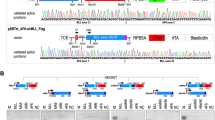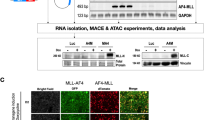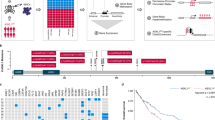Abstract
The t(10;11)(p12;q14) is a recurring chromosomal translocation that gives rise to the CALM/AF10 fusion gene, which is found in acute myeloid leukemia, acute lymphoblastic leukemia and malignant lymphoma. We analyzed the fusion transcripts in 20 new cases of CALM/AF10-positive leukemias, and compared the gene expression profile of 10 of these to 125 patients with other types of leukemia and 10 normal bone marrow samples. Based on gene set enrichment analyses, the CALM/AF10-positive samples showed significant upregulation of genes involved in chromatin assembly and maintenance and DNA repair process, and downregulation of angiogenesis and cell communication genes. Interestingly, we observed a striking upregulation of four genes located immediately centromeric to the break point of the t(10;11)(p12;q14) on 10p12 (COMMD3 (COMM domain containing 3), BMI1 (B lymphoma Mo-MLV insertion region 1 homolog), DNAJC1 (DnaJ (Hsp40) homolog subfamily C member 1) and SPAG6 (sperm associated antigen 6)). We also conducted semiquantitative reverse transcriptase-PCR analysis on leukemic blasts from a murine CALM/AF10 transplantation model that does not have the translocation. Commd3, Bmi1 and Dnajc1, but not Spag6 were upregulated in these samples. These results strongly indicate that the differential regulation of these three genes is not due to the break point effect but as a consequence of the CALM/AF10 fusion gene expression, though the mechanism of regulation is not well understood.
This is a preview of subscription content, access via your institution
Access options
Subscribe to this journal
Receive 12 print issues and online access
$259.00 per year
only $21.58 per issue
Buy this article
- Purchase on Springer Link
- Instant access to full article PDF
Prices may be subject to local taxes which are calculated during checkout






Similar content being viewed by others
References
Dreyling MH, Martinez-Climent JA, Zheng M, Mao J, Rowley JD, Bohlander SK . The t(10;11)(p13;q14) in the U937 cell line results in the fusion of the AF10 gene and CALM, encoding a new member of the AP-3 clathrin assembly protein family. Proc Natl Acad Sci USA 1996; 93: 4804–4809.
Rosenwald A, Ott G, Krumdiek AK, Dreyling MH, Katzenberger T, Kalla J et al. A biological role for deletions in chromosomal band 13q14 in mantle cell and peripheral t-cell lymphomas? Genes Chromosomes Cancer 1999; 26: 210–214.
Chaplin T, Ayton P, Bernard OA, Saha V, Della Valle V, Hillion J et al. A novel class of zinc finger/leucine zipper genes identified from the molecular cloning of the t(10;11) translocation in acute leukemia. Blood 1995; 85: 1435–1441.
Linder B, Newman R, Jones LK, Debernardi S, Young BD, Freemont P et al. Biochemical analyses of the AF10 protein: the extended LAP/PHD-finger mediates oligomerisation. J Mol Biol 2000; 299: 369–378.
Saha V, Chaplin T, Gregorini A, Ayton P, Young BD . The leukemia-associated-protein (LAP) domain, a cysteine-rich motif, is present in a wide range of proteins, including MLL, AF10, and MLLT6 proteins. Proc Natl Acad Sci USA 1995; 92: 9737–9741.
Greif PA, Tizazu B, Krause A, Kremmer E, Bohlander SK . The leukemogenic CALM//AF10 fusion protein alters the subcellular localization of the lymphoid regulator Ikaros. Oncogene 2007; 27: 2886–2896.
Lin YH, Kakadia PM, Chen Y, Li YQ, Deshpande AJ, Buske C et al. Global reduction of the epigenetic H3K79 methylation mark and increased chromosomal instability in CALM-AF10-positive leukemias. Blood 2009; 114: 651–658.
Li H, Ilin S, Wang W, Duncan EM, Wysocka J, Allis CD et al. Molecular basis for site-specific read-out of histone H3K4me3 by the BPTF PHD finger of NURF. Nature 2006; 442: 91–95.
Peña PV, Davrazou F, Shi X, Walter KL, Verkhusha VV, Gozani O et al. Molecular mechanism of histone H3K4me3 recognition by plant homeodomain of ING2. Nature 2006; 442: 100–103.
Barski A, Cuddapah S, Cui K, Roh TY, Schones DE, Wang Z et al. High-resolution profiling of histone methylations in the human genome. Cell 2007; 129: 823–837.
Meyer C, Schneider B, Jakob S, Strehl S, Attarbaschi A, Schnittger S et al. The MLL recombinome of acute leukemias. Leukemia 2006; 20: 777–784.
Klebig ML, Wall MD, Potter MD, Rowe EL, Carpenter DA, Rinchik EM . Mutations in the clathrin-assembly gene Picalm are responsible for the hematopoietic and iron metabolism abnormalities in fit1 mice. Proc Natl Acad Sci USA 2003; 100: 8360–8365.
Meyerholz A, Hinrichsen L, Groos S, Esk PC, Brandes G, Ungewickell EJ . Effect of clathrin assembly lymphoid myeloid leukemia protein depletion on clathrin coat formation. Traffic 2005; 6: 1225–1234.
Tebar F, Bohlander SK, Sorkin A . Clathrin assembly lymphoid myeloid leukemia (CALM) protein: localization in endocytic-coated pits, interactions with clathrin, and the impact of overexpression on clathrin-mediated traffic. Mol Biol Cell 1999; 10: 2687–2702.
Ahle S, Ungewickell E . Purification and properties of a new clathrin assembly protein. EMBO J 1986; 5: 3143–3149.
Takei K, Mundigl O, Daniell L, De Camilli P . The synaptic vesicle cycle: a single vesicle budding step involving clathrin and dynamin. J Cell Biol 1996; 133: 1237–1250.
Carlson KM, Vignon C, Bohlander S, Martinez-Climent JA, Le Beau MM, Rowley JD . Identification and molecular characterization of CALM/AF10 fusion products in T cell acute lymphoblastic leukemia and acute myeloid leukemia. Leukemia 2000; 14: 100–104.
Deshpande AJ, Cusan M, Rawat VPS, Reuter H, Krause A, Pott C et al. Acute myeloid leukemia is propagated by a leukemic stem cell with lymphoid characteristics in a mouse model of CALM/AF10-positive leukemia. Cancer Cell 2006; 10: 363–374.
Caudell D, Zhang Z, Chung YJ, Aplan PD . Expression of a CALM-AF10 fusion gene leads to Hoxa cluster overexpression and acute leukemia in transgenic mice. Cancer Res 2007; 67: 8022–8031.
Caudell D, Aplan PD . The role of CALM-AF10 gene fusion in acute leukemia. Leukemia 2008; 22: 678–685.
Okada Y, Feng Q, Lin Y, Jiang Q, Li Y, Coffield VM et al. hDOT1L links histone methylation to leukemogenesis. Cell 2005; 121: 167–178.
Okada Y, Jiang Q, Lemieux M, Jeannotte L, Su L, Zhang Y . Leukaemic transformation by CALM-AF10 involves upregulation of Hoxa5 by hDOT1L. Nat Cell Biol 2006; 8: 1017–1024.
Dik WA, Brahim W, Braun C, Asnafi V, Dastugue N, Bernard OA et al. CALM-AF10+ T-ALL expression profiles are characterized by overexpression of HOXA and BMI1 oncogenes. Leukemia 2005; 19: 1948–1957.
Asnafi V, Radford-Weiss I, Dastugue N, Bayle C, Leboeuf D, Charrin C et al. CALM-AF10 is a common fusion transcript in T-ALL and is specific to the TCRgammadelta lineage. Blood 2003; 102: 1000–1006.
Bohlander SK, Muschinsky V, Schrader K, Siebert R, Schlegelberger B, Harder L et al. Molecular analysis of the CALM/AF10 fusion: identical rearrangements in acute myeloid leukemia, acute lymphoblastic leukemia and malignant lymphoma patients. Leukemia 2000; 14: 93–99.
Narita M, Shimizu K, Hayashi Y, Taki T, Taniwaki M, Hosoda F et al. Consistent detection of CALM-AF10 chimaeric transcripts in haematological malignancies with t(10;11)(p13;q14) and identification of novel transcripts. B J Haematol 1999; 105: 928–937.
Salmon-Nguyen F, Busson M, Daniel M, Leblanc T, Bernard OA, Berger R . CALM-AF10 fusion gene in leukemias: simple and inversion-associated translocation (10;11). Cancer Genet Cytogenet 2000; 122: 137–140.
Ayton PM, Cleary ML . Transformation of myeloid progenitors by MLL oncoproteins is dependent on Hoxa7 and Hoxa9. Genes Dev 2003; 17: 2298–2307.
Blatt C, Sachs L . Deletion of a homeobox gene in myeloid leukemias with a deletion in chromosome 2. Biochem Biophys Res Commun 1988; 156: 1265–1270.
Kroon E, Krosl J, Thorsteinsdottir U, Baban S, Buchberg AM, Sauvageau G . Hoxa9 transforms primary bone marrow cells through specific collaboration with Meis1a but not Pbx1b. EMBO J 1998; 17: 3714–3725.
Soulier J, Clappier E, Cayuela JM, Regnault A, Garcia-Peydro M, Dombret H et al. HOXA genes are included in genetic and biologic networks defining human acute T-cell leukemia (T-ALL). Blood 2005; 106: 274–286.
Thorsteinsdottir U, Kroon E, Jerome L, Blasi F, Sauvageau G . Defining roles for HOX and MEIS1 genes in induction of acute myeloid leukemia. Mol Cell Biol 2001; 21: 224–234.
Pineault N, Buske C, Feuring-Buske M, Abramovich C, Rosten P, Hogge DE et al. Induction of acute myeloid leukemia in mice by the human leukemia-specific fusion gene NUP98-HOXD13 in concert with Meis1. Blood 2003; 101: 4529–4538.
Dik WA, Brahim W, Braun C, Asnafi V, Dastugue N, Bernard OA et al. CALM-AF10+ T-ALL expression profiles are characterized by overexpression of HOXA and BMI1 oncogenes. Leukemia 2005; 19: 1948–1957.
van Lohuizen M, Verbeek S, Scheijen B, Wientjens E, van der Gulden H, Berns A . Identification of cooperating oncogenes in E mu-myc transgenic mice by provirus tagging. Cell 1991; 65: 737–752.
Iwama A, Oguro H, Negishi M, Kato Y, Morita Y, Tsukui H et al. Enhanced self-renewal of hematopoietic stem cells mediated by the polycomb gene product Bmi-1. Immunity 2004; 21: 843–851.
Oguro H, Iwama A, Morita Y, Kamijo T, van Lohuizen M, Nakauchi H . Differential impact of Ink4a and Arf on hematopoietic stem cells and their bone marrow microenvironment in Bmi1-deficient mice. J Exp Med 2006; 203: 2247–2253.
Leung C, Lingbeek M, Shakhova O, Liu J, Tanger E, Saremaslani P et al. Bmi1 is essential for cerebellar development and is overexpressed in human medulloblastomas. Nature 2004; 428: 337–341.
Prince ME, Sivanandan R, Kaczorowski A, Wolf GT, Kaplan MJ, Dalerba P et al. Identification of a subpopulation of cells with cancer stem cell properties in head and neck squamous cell carcinoma. Proc Natl Acad Sci USA 2007; 104: 973–978.
Ferreira BI, Garcia JF, Suela J, Mollejo M, Camacho FI, Carro A et al. Comparative genome profiling across subtypes of low-grade B-cell lymphoma identifies type-specific and common aberrations that target genes with a role in B-cell neoplasia. Haematologica 2008; 93: 670–679.
Subramanian A, Tamayo P, Mootha VK, Mukherjee S, Ebert BL, Gillette MA et al. Gene set enrichment analysis: a knowledge-based approach for interpreting genome-wide expression profiles. Proc Natl Acad Sci USA 2005; 102: 15545–15550.
Shimada M, Nakanishi M . DNA damage checkpoints and cancer. J Mol Histol 2006; 37: 253–260.
Clapier CR, Cairns BR . The biology of chromatin remodeling complexes. Annu Rev Biochem 2009; 78: 273–304.
Bao Y, Shen X . Chromatin remodeling in DNA double-strand break repair. Curr Opin Genet Dev 2007; 17: 126–131.
Misteli T, Soutoglou E . The emerging role of nuclear architecture in DNA repair and genome maintenance. Nat Rev Mol Cell Biol 2009; 10: 243–254.
Rodrigue A, Lafrance M, Gauthier MC, McDonald D, Hendzel M, West SC et al. Interplay between human DNA repair proteins at a unique double-strand break in vivo. EMBO J 2006; 25: 222–231.
Hussong JW, Rodgers GM, Shami PJ . Evidence of increased angiogenesis in patients with acute myeloid leukemia. Blood 2000; 95: 309–313.
Kini AR, Kay NE, Peterson LC . Increased bone marrow angiogenesis in B cell chronic lymphocytic leukemia. Leukemia 2000; 14: 1414–1418.
Padro T, Ruiz S, Bieker R, Burger H, Steins M, Kienast J et al. Increased angiogenesis in the bone marrow of patients with acute myeloid leukemia. Blood 2000; 95: 2637–2644.
Leroy P, Berto F, Bourget I, Rossi B . Down-regulation of Hox A7 is required for cell adhesion and migration on fibronectin during early HL-60 monocytic differentiation. J Leukoc Biol 2004; 75: 680–688.
Acknowledgements
We acknowledge Claudia Haferlach, Torsten Haferlach, Susanne Schnittger and Alexander Kohlmann for contributing patient samples and some of the expression data to this work. We are thankful to Stefan Bentink and Reiner Spang for developing R scripts for this analysis. A Krause and M Mulaw were supported by a DAAD (German Academic Exchange Service) exchange fellowship. C Lottaz was supported by the BMBF (Leukemia Net). C Buske received support from the Deutsche Forschungsgemeinschat (SFB 684-A8). This work was supported by grants from the German Ministry of Research and Education (Leukemia net, BMBF; 01GS0448) and the Deutsche Forschungsgemeinschaft (SFB 684-A6) to SK Bohlander.
Author contributions
SKB designed the experiments and the study; AJK did sample preparation for microarray study and sequencing; MAM and SKB did the statistical data analysis and interpretation of the microarray results; MAM, AJK and SKB wrote the manuscript; CB, AJD and AR provided the CALM/AF10 bone marrow transplantation model samples for RT-PCR, which was done by AJK; RLS, AB, CM and WDL provided patient samples; CL helped in statistical data analysis.
Author information
Authors and Affiliations
Corresponding author
Ethics declarations
Competing interests
The authors declare no conflict of interest.
Additional information
Supplementary Information accompanies the paper on the Leukemia website
Rights and permissions
About this article
Cite this article
Mulaw, M., Krause, A., Deshpande, A. et al. CALM/AF10-positive leukemias show upregulation of genes involved in chromatin assembly and DNA repair processes and of genes adjacent to the breakpoint at 10p12. Leukemia 26, 1012–1019 (2012). https://doi.org/10.1038/leu.2011.307
Received:
Revised:
Accepted:
Published:
Issue Date:
DOI: https://doi.org/10.1038/leu.2011.307
Keywords
This article is cited by
-
SPAG6 regulates cell proliferation and apoptosis via TGF-β/Smad signal pathway in adult B-cell acute lymphoblastic leukemia
International Journal of Hematology (2024)
-
Unexpected variation in leukemia stem cell frequency and genetic heterogeneity in two murine leukemia models initiated by AML1/ETO9a and CALM/AF10
Leukemia (2020)
-
Dysregulated transcriptional networks in KMT2A- and MLLT10-rearranged T-ALL
Biomarker Research (2018)
-
Spag6 Mutant Mice Have Defects in Development and Function of Spiral Ganglion Neurons, Apoptosis, and Higher Sensitivity to Paclitaxel
Scientific Reports (2017)
-
The target cell of transformation is distinct from the leukemia stem cell in murine CALM/AF10 leukemia models
Leukemia (2016)



